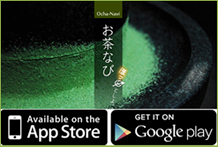HOME > Chronological Table of History and Development of Uji-cha tea
Chronological Table of History and Development of Uji-cha tea
The development of Japanese tea originates from Ujicha tea and expands widely to the nation, and is leading to the present.
Beginning of Uji-cha tea Production and Development
“Maccha (Ohishita Cultivation)”: After the 12th Century
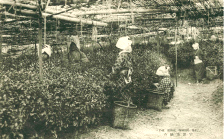
Keeping 400 years of tradition, Natural handpicking at Honzu-chaen (tea field covered with reeds)
Around this time, Ohishita cultivation where they cover the whole field with reed or straw was started and “Ohishita-chaen”, which was unseen in the world started to appear. Also, abundant amount of rape seed oil, koji, dried sardine, and manure from Kyoto made the soil rich in organic nitrogen fertilizer. From this, unlike “maccha” with strong bitterness with Roji cultivation, “maccha” with bright deep green color and strong flavor unique in Japan was grown with Ohishita cultivation.
After the 17th century, due to the patronage of Tokugawa Shogun family, the system of “Ochatsubodochu” where new tea was delivered from Uji to Edo every year was institutionized. Uji-chashi who produce and sell Uji-cha tea created a blend called Gogumi and made many creations like blending tea for tea ceremony masters in Kyoto.
As a result, in Uji, there are villages that consist of Ohishita-chaen and tea production facilities (tea factories) and townscape that consist of houses of Uji-chashi.
Revolution of Uji-cha tea Production
“Sencha (Roji cultivation)”, “Gyokuro (Ohishita cultivation)”: After 17th century
In the mid-17th Encha-ho method, steeming knead tea leaves into hot water to drink its essesce, was passed down from Ingen who opened Manpukuji in Uji. In the 18th century, Uji production method (Aosei Sencha Seiho) , which steam tea leaves are kneaded by hand and dried, was created by tea farmers mainly in Ujitawara Yuyadani and Uji, and “sencha” was started in which the color, scent, and flavor was unique in Japan. This Uji production method was spread all over the country by the producers in Ujitawara and Uji by the end of the 19th century, and it is the basic production method for “Sencha” now.
Also, “sencha” produced in Ujitawara found market mainly in Edo. Therefore, Yuyadani, Ujitawara City has village with tea farmers that produce “sencha” and wholesalers and Gonokuchi in the same town has townscape with the important point of the water traffic and tea wholesalers that deal with“sencha”.
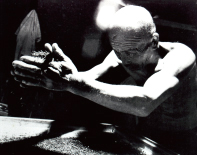 As “sencha” spread, field called “yamanari kaikon” that opened up the field using the slope of the landscape spread the cultivation area of “sencha” using roji cultivation in Ujitawara-cho and Wazuka-cho. Furthermore, by the end of the open port at the end of the Edo period, “sencha”was exported via Yokohama Port and Kobe Port, whichmade contribution to earning foreign currency by taking part in the export industry as exported goods mainly to the American market. Around this time, the mountain area such as Minamiyamashiro Village became a tea production area.
As “sencha” spread, field called “yamanari kaikon” that opened up the field using the slope of the landscape spread the cultivation area of “sencha” using roji cultivation in Ujitawara-cho and Wazuka-cho. Furthermore, by the end of the open port at the end of the Edo period, “sencha”was exported via Yokohama Port and Kobe Port, whichmade contribution to earning foreign currency by taking part in the export industry as exported goods mainly to the American market. Around this time, the mountain area such as Minamiyamashiro Village became a tea production area.
Also, in the early 19th century, the Ohishita cultivation in Uji and Uji production method came together and created “Gyokuro”, which is the best tea production technology in Uji-cha tea. Among the green tea grown in Ohishita cultivation, “maccha” was allowed to be grown only by Uji-chashi (the premier Uji tea makers)Uji tea grower until the late 19th century. Since “Gyokuro” did not have any regulation, Ohishita-chaen spread to areas along Kizugawa River and its riverbed and hills in current Joyo City and Kyotanabe City
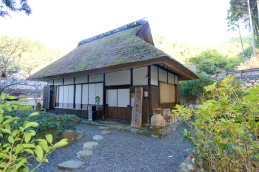 As a result, tea production in Yamashiro area in the south Kyoto spread to hills, slopes, and river bed instead of just staying on the flat ground. Villages were formed based on the fields of Ohishita-chaen, Yamanari kaikon, and Roji-chaen that are good for “maccha”, “sencha”, and “gyokuro” and tea–production-related facilities.
As a result, tea production in Yamashiro area in the south Kyoto spread to hills, slopes, and river bed instead of just staying on the flat ground. Villages were formed based on the fields of Ohishita-chaen, Yamanari kaikon, and Roji-chaen that are good for “maccha”, “sencha”, and “gyokuro” and tea–production-related facilities.
From the 18th century to the 19th century, Bunjincha using “sencha” was popular among writers and artists so “sencha” and “gyokuro” produced in Uji production method was used actively. The blending techniques of tea merchants were developed in order to keep its various flavor and quality consistent.
During Meiji Restoration (1868), “sencha” production area in Yamashiro area in the south Kyoto started to produce more for exportation using the water transport of Kizugawa River. Kamikoma in Kizugawa City had cotton merchants that also worked in tea industry but around this time, they specialized in tea industry doing blending and wholesale.
As a result, Kamikoma has a townscape that is formed with tea wholesalers using the geographic advantage with transportation connection.
Development of Uji-cha tea Production
After the 20th Century
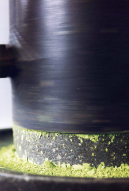 Although the tea industry had developed, the production such as picking and kneading were all done with hands. On the other hand, the production of tea leaves had increased due to the increase of tea field and improvement of cultivation technology. As a result, mechanization of tea production was inquired. For “maccha”, tea production machine was developed in Uji and for “sencha”, tea production machine that imitates “hand kneading” perfectly was developed in order to prevent mass production of inferior good in the country. Also, machines were developed for picking tea leaves. The mechanization spread to Yamashiro area in the south Kyoto and the area worked hard to maintain the quality. Also, there were technological innovation for related goods such as motorizing the tea grinding motor to crush the tencha into maccha and tea box to store the tea leaves.
Although the tea industry had developed, the production such as picking and kneading were all done with hands. On the other hand, the production of tea leaves had increased due to the increase of tea field and improvement of cultivation technology. As a result, mechanization of tea production was inquired. For “maccha”, tea production machine was developed in Uji and for “sencha”, tea production machine that imitates “hand kneading” perfectly was developed in order to prevent mass production of inferior good in the country. Also, machines were developed for picking tea leaves. The mechanization spread to Yamashiro area in the south Kyoto and the area worked hard to maintain the quality. Also, there were technological innovation for related goods such as motorizing the tea grinding motor to crush the tencha into maccha and tea box to store the tea leaves.
Since the mid-20th century, creation of group tea field, joint tea production factory, tea-production-related facilities such as frost prevention facility has been kept up in this area until now for promoting tea industry. Also in this area, they still have Ohishita-chaen that uses reed and straws as well as traditional reed and cheesecloth, and does natural hand picking.
As it showed, “The Landscapes of Uji-cha tea production” includes land usage and facilities related to cultivation, production, and distribution as well as all elements composing the historical changes and variations of Uji-cha tea production and it inherits all elements interrelated to one another and continuing until today.
chronological table
The history of Yamashiro … Green Text
The history of Ujicha tea … White Text
| The time | History of Ujicha | |
|---|---|---|
Heian Period(794~1185) |
From Tang, Sencha method of tea leaves that were steamed and not hand-rolled was introduced. 【Culture of boiling tea】 |
|
| 815 | They ordered to plant tea in Kinai area including Yamashiro and to present it. (“Nihon Kouki” 【The oldest record of the appearance of tea】) |
|
| Tea from Heian Daidairi tea field was used at “Kinomidokyo” imperial court ceremony. | ||
| 1053 | Byodo-in Temple Hoodo (Phoenix Temple) built. | |
| 1102 | Shirakawa Konjikiin (Gold Institute) built. | |
| 1107 | Joruri-ji Kutai-amida-do (nine bodies Buddha) built. | |
Kamakura Period(1185~1333) |
From Sung, Tencha method of tea leaves that were steamed and not hand-rolled was introduced 【Culture of dissolving tea in hot water】 |
|
| Tea cultivation was started in Tsugao. | ||
| 1222 | Priest Jishin of Kaijusenji-temple excavated land of Makinohara Oide, it is so reported. | |
| 1331 | Kasagidera temple was destroyed by fire in revolt of the Genko era. | |
| Tea cultivation was started in Uji | ||
Nanbokucho Period(1334~1392) |
1343 | Tocha tea-tasting contest (Chakabuki) was popular Tea cultivation in Uji is presumed to have been started at least by the end of Kamakura period.(“Shinsyuki”【first historical source about Ujicha-tea】) |
Muromachi Period(1393~1573) |
1428 | Peasant uprising of the Shocho era. | around1476 | Tea from Uji and Tsugao became the top brand tea favored by the emperor and shogun family. |
| Early tea brand of “Mujo” and “Betsugi” was created 【Uji-chashi widely operated tea field mainy in Ujigo, and developed better products】 |
||
| 1481 | Ikkyu Sojun dies. | |
| 1485 | Uprising in Yamashiro Province. | |
| It’s first in the 16th century. | Start of Chanoyu | |
| The second half in the 16th century | Establishment of 7 famous fields in Uji | |
| Appearance of Ohishita-chaen (Uji City)
Apperance of unique Japanese maccha
|
||
| Housing street of Uji-chashi who produced tea for Chanoyu in Nakauji was formed. | ||
Azuchi Momoyama Period(around1573~1603) |
1573 | Nobunaga Oda defeated shogunate Yoshiaki Ashikaga in Uji Makishima. Muromachi Shogunate extinguished. | 1577 | Portuguese missionary Joan Rodrigues mentioned about Ohishita-chaen in Uji in “Church history in Japan” |
| 1582 | Honnoji-temple Incident, Battle of Yamasaki. | |
| 1584 | ideyoshi Toyotomi issued “prohibition”to give the privilege to Ujigo | |
| 1587 | Hideyoshi Toyotomi held a large tea party in Kyoto Kitano | |
| Completion of Chanoyu (Sennorikyu) | ||
Early Edo Period(around1603~1691) |
1632 | System of Ochatsubodochu was established (It continued until the end of Edo period for about 250 years) 【Uji-chashi innovated the blend called Aigumi, and created tea that was favored by tea ceremony master in Kyoto and other places】 |
| 1639 | Shojo Shokado dies. | |
| 1654 | From Ming, Encha method of tea, made by Kamairi (roasted on a pan) and hand-rolled, was introduced. 【Culture of steeping tea in hot water to drink the essence】 |
|
| 1663 | Priest Ingen established Manpukuji temple in Uji. | |
| 1690 | German doctor Kaempfer mentioned in “Nihonshi” (The History of Japan) about Uji-cha tea. | |
Mid-Edo PEriod(1692~1779) |
1712 | Kizugawa river grear flood. | 1735 | Baisao established tea house called Tsusentei in Higashiyama, Kyoto 【Trigger which made sencha popular among writers and the intellectuals】 |
| 1738 | Uji production method (Aosei Sencha Seiho) was invented (Ujitawara-cho)
Birth of Sencha-tea by deep-steam manufacturing method
|
|
| Sencha became very popular in Edo | ||
| Uji production method was spread all over the country by the end Edo Period. | ||
Late Edo Period(1780~1867) |
Production area of senchawas expanded with tea fields creation. | |
| 1835 | Gyokuro was created (Uji City)
Appearance of Gyokuro
|
|
| Ohishita cultivation was expanded to riverbed of Kizugawa River and hills | ||
| 1859 | Yokohama Port opened (beginning of Japanese tea exportation) | |
| Streets of tea wholesalers were formed at Kamikoma along Kizugawa River where is the trading center of Uji-cha tea. | ||
| 1867 | Kobe port opened 【Uji-cha tea made contribution to earning foreign currency as a main exportation good】 【Tea wholesalers were the base for exportation】 |
|
Meiji Period(1868~1912) |
Opened Yamanari tea field (enhancement of sencha production system) | |
| 1870 | Dosenbou reclamation begins. | |
| 1876 | The government control railroad (existing JR) opened traffic between Osaka and Kyoto. | |
| Tea ceremony was introduced in the education of women | ||
| Uji-cha tea was spread to the general homes because they started selling domestically instead of export | ||
| 1901 | Kizu Agricultural School opened | |
Taisho Period(1912~1926) |
Processing tea with machine increased. | |
Showa Period(1926~1989) |
1955 | plucking by hand scissors began. |
| 1965 | plucking by portable plucker began. Reclamation of Yamanari tea field (land reclamation at the original slope for tea field), installation of anti-frost fans began. |
|
Heisei Period(1989~) |
1998 | plucking by sulky type tea leaf plucker began. Land formation of a group tea garden by topography improvement. |

